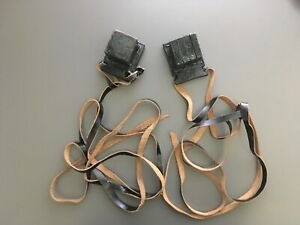Phylacteries. Leather boxes that are bound around the forehead & left arm with leather straps. They contain small, rolled Torah parchments which correspond with the passages referring to tefillin.
Etymology: Tefillin is related to the Hebrew word for prayer – t’phillah תְּפִלָּה (Strong’s 8605) – but is the Aramaic plural form.

The rabbinical Jewish establishment bases the use of tefillin on a literal interpretation of Exodus 13:9, Exodus 13:16, Deut 6:6-8, and Deut 11:18, although many scholars have argued for a figurative interpretation.
Relevant Vocabulary
In looking at the passages, it is important to become acquainted with some of the Hebrew words.
First are the Hebrew words owth אוֹת (h226) & totafot טוֹטָפוֹת (h2903). The former refers to the “sign” on the hand & the latter to the “frontlet” between the eyes. These are repeated in the passages mentioned above.
The word “totafot” only occurs here in the relevant passages & nowhere else, and the derivation & meaning is not clear.
In the Septuagint, the ancient Jewish translators decided to translate totafot with the Greek word ἀσάλευτος (g761), which means “immovable thing” or something firmly held in place.
In Exodus 13:9, the text uses the word memorial (or reminder) – זִכָּרוֹן (h2146) instead of totafot.
Binding
The passages in Deuteronomy speak of tying, or binding the sign (owth) upon the hand, using the Hebrew word קָשַׁר (h7194). No verb is used in reference to attaching the totafot.
Keep in mind that, in favor of a figurative interpretation, words for tie & bind are also used in the following verses in Proverbs in a metaphorical sense:
- Prov 3:3
- Prov 6:21
- Prov 7:3
New Testament
Jesus refers to the Pharisees’ tefillin in Matthew 23:5, saying, “But they do all their deeds to be noticed by men; for they broaden their phylacteries and lengthen the tassels of their garments.” NASB
The word here is the Greek word φυλακτήριον (g5440) “phylacterion,” meaning amulet & is where we get the word phylactery.
Origin
There is no evidence for the existence or use of tefillin in archeological or historical sources until the second century BC.

There are many theories surrounding their origin, but a leading theory suggests that they were appropriated from the amulets of other Mediterranean cultures. The use of tefillin seemed to be a practice limited to the Pharisees, at least during the Second Temple era.
For an excellent exploration of the origin of tefillin, please read Dr. Yehudah Cohn’s article on Torah.com.
